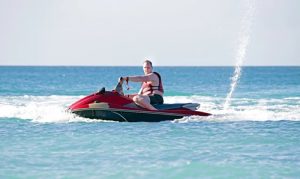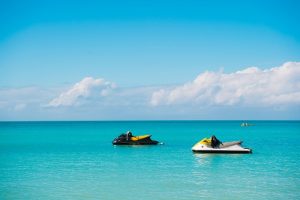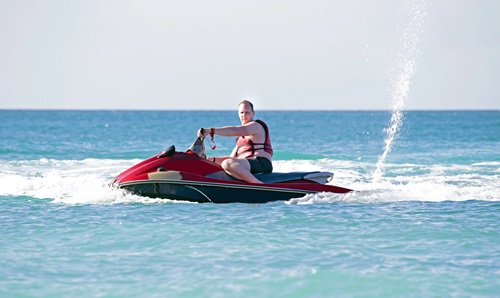 We’ve reached the third and final chapter of our How to Ride a Jet Ski: A Beginner’s Guide series. It’s been quite a ride so far, hasn’t it? In our previous discussions, we’ve covered all the essentials, from getting started to staying safe on the water. Now, we’re gearing up for the most exciting part of your jet skiing journey – advanced techniques, handling diverse water conditions, and unlocking the full potential of your jet ski. So, grab your life jacket and hop on board, because we’re about to dive deep into the world of jet skiing!
We’ve reached the third and final chapter of our How to Ride a Jet Ski: A Beginner’s Guide series. It’s been quite a ride so far, hasn’t it? In our previous discussions, we’ve covered all the essentials, from getting started to staying safe on the water. Now, we’re gearing up for the most exciting part of your jet skiing journey – advanced techniques, handling diverse water conditions, and unlocking the full potential of your jet ski. So, grab your life jacket and hop on board, because we’re about to dive deep into the world of jet skiing!
Making the Most of Your Jet Ski Adventure
Riding a jet ski can be super exciting, but it’s also important to stay safe while having fun. Whether you’re new to jet skiing or just want some useful tips, this section has got you covered with practical advice to make your jet skiing experience safe and enjoyable.
Getting the Most Thrill from Jet Skiing
Jet skiing in Myrtle Beach is all about the thrill of speed and freedom on the water. If you’re new to it, here are some tips to help you have an amazing time while staying safe:
- Start Slowly: Begin at a comfortable speed to get used to how the jet ski handles. As you gain confidence, you can gradually go faster.
- Explore Different Places: Try jet skiing in various water conditions and locations, like calm lakes or the open ocean, to enjoy different experiences.
- Learn the Basics: Practice simple moves like turns, stops, and adjusting your speed. This will make you more in control and increase your enjoyment.
- Join Guided Tours: If you’re in a place with guided tours, consider joining one. They provide a safe way to explore while having a blast.
- Be Aware: Always pay attention to other people on the water and any obstacles. Staying aware is essential for both safety and fun.
 What Should You Bring?
What Should You Bring?
Here’s a checklist of things to bring for your Myrtle Beach jet ski ride:
- Enough Fuel: Check your fuel gauge to avoid getting stranded.
- Signaling Device: Carry a whistle, horn, or another device to signal for help if needed.
- Navigation: Bring a GPS device or map in case you get lost.
- Safety Equipment: Make sure you have all the required safety gear for your class, including a Coast Guard-approved life jacket.
- Proper Clothing: Wear water-specific clothing and gear, like gloves to protect your hands and improve your grip.
- Certification: Have any required certifications or licenses for operating a jet ski in Myrtle Beach.
- Documentation: Keep your vessel registration and other necessary documents handy.
- Fire Extinguisher: Carry a Coast Guard-approved fire extinguisher and know how to use it safely.
- Backfire Flame Arrestor: Ensure it’s functional, and understand how it works.
Riding Tips for Beginners
Here are some additional tips for beginner riders:
- Safety First: Learn the rules and regulations that apply to jet skiing in your area, and don’t become overconfident while learning.
- Keep It Straight: To maintain a straight course, look off into the distance instead of staring at the handlebars or water right in front of you.
- Relax Your Grip: Don’t hold on too tightly; lean forward slightly and keep your elbows bent to reduce fatigue.
- Comfortable Passenger: If you’re riding with someone, hold onto their waist or the back of their life jacket, but don’t grip too tightly.
- Correct Wakes: Cross wakes or large waves at a 90° angle and jump them instead of plowing through at high speed.
- Practice: Riding it safely and correctly takes practice, so follow these tips, and you’ll improve with time.
 FAQs – Common Questions Answered
FAQs – Common Questions Answered
Here are answers to common questions:
- Jet skis are relatively easy to drive, especially beginner-friendly models designed for stability and ease of use.
- For beginners, start by understanding basic operations, like steering and accelerating, and gradually increase speed as you gain confidence.
- The best unit for beginners is one that offers stability, easy handling, and moderate speed.
- Before riding, be familiar with safety rules, know how to operate it, and follow local regulations.
- Units for newbies typically have a top speed of 40-50 mph, but beginners should start at lower speeds.
- Throttle control is crucial for steering because they steer using water jet thrust.
- Jet skiing is possible for non-swimmers if they wear a life jacket and stay in calm, supervised areas.
- Pregnant women are generally advised to ride jet skis, especially in later pregnancy stages.
- The legal age for operating a jet ski rental varies by location; always check local regulations.
- To reboard, use the handle behind the seat and approach from the back (stern).
- Reboarding can be difficult in rough waters or when fatigued, so take your time and use controlled movements.
- The intake grate and impeller at the back are dangerous to hands, feet, and hair due to the risk of entanglement or injury.
- Shutting off the engine results in a loss of propulsion and steering.
- The speeds vary by model, with recreational models reaching speeds of 40-60 mph.
- Yes, you’ll likely get wet, even if you don’t fall in – it’s part of the fun!
- Typically, wear a bathing suit and a Coast Guard-approved life vest or PFD, with additional layers for colder water or weather.
- While any activity involves some risk, listening to guides and following safety guidelines can reduce the risk of injury.
Check other links here:
Ready to hit the waves? Stay safe and have a blast on your jet ski adventure! Call Action Water Sportz now.
Like our Facebook page for more information on jet ski rentals.
Action Water Sportz
1525 13th Ave N
North Myrtle Beach, SC 29582
(843) 280-4100
http://www.actionwatersportz.com/
Action Water Sportz Little River
4430 Kingsport Road
Little River SC 29566
843-280-3100

